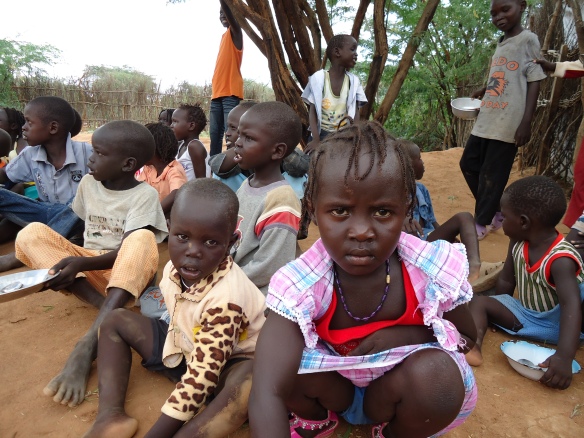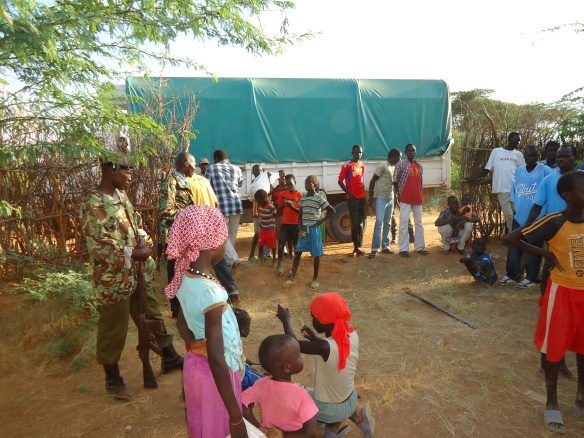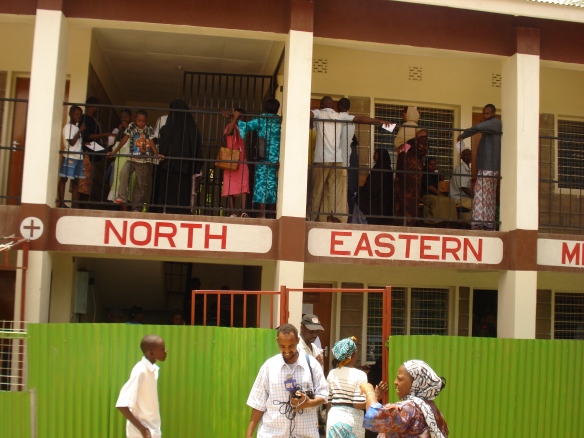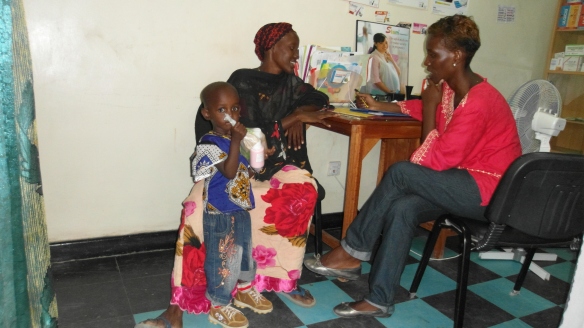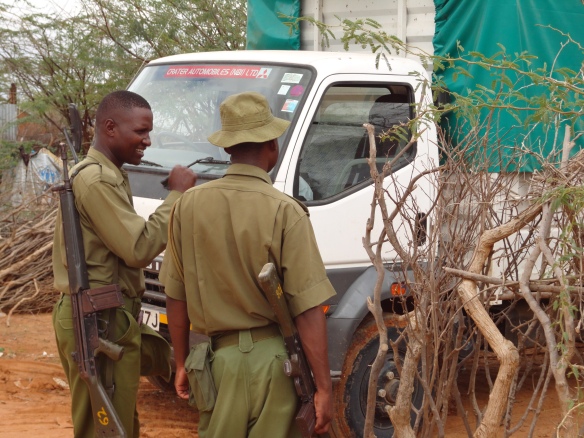Text and images by humanitarian photographer Robin Wyatt.
Dadaab now qualifies as Kenya’s third largest city, after Nairobi and Mombasa. It consists of three refugee camps – Hagadera, Ifo and Dagahaley – with a total population of around 400,000 and counting. The vast majority of these are Somali Muslims; the small number of Christians who also call Dadaab home are seldom spoken of. These Christians, coming from Sudan, Ethiopia, Congo, Uganda and Burundi, fled their homelands at different times during the last two decades, escaping civil war and violent persecution.
TSM, whose work on drought relief and mitigation in North Eastern Kenya I documented in my photo essay entitled ‘Building Hope in the Face of Drought’, help to address the particular needs of Dadaab’s Christians. Uppermost on their priority list is a group of Christians that hardly anyone is even aware of: a handful of Somali refugees who declare an outward allegiance to Islam but are quietly practising Christianity behind closed doors. TSM refer to these Christians as ‘Muslim Background Believers’ (MBBs). It was unfortunately not permitted for me to photograph or even meet with these people, as doing so could pose a very real threat to their security. Indeed, Christians from other African countries also experience considerable obstacles owing to their faith.
While at Dadaab under TSM’s auspices, I was able to attend three Sunday church services and one community’s Saturday prayer meeting. I also met with both church elders and members of their congregations. This photo essay is my effort to share what I learned about life as a Christian in the world’s largest refugee camp.
All of the images below were captured by humanitarian photographer Robin Wyatt. They may be purchased as beautiful colour prints and high resolution downloads, as well as greetings cards and eCards (eCards are free). To make your selection, just click directly on the image that interests you and you will be taken to the gallery entitled ‘Dadaab’s Christians’ in Robin’s Image Archives.
This is Dadaab International Worship Centre. It gives space for Christians of all persuasions to worship together, and counts attendees from around 50 denominations every Sunday. Most of its congregation work for the agencies of the United Nations (UN) and large NGOs that are permanently operating at Dadaab. For worshippers’ protection, the church is located just across from the UN compound and within the grounds of Dadaab’s main police station.

While the video above arguably shows what one might find in a church in any modern city in Africa, this image shows what most of us think of when we imagine the living situation of refugees in a camp like Dadaab. However, the majority of the Christians in Dadaab don't actually live like this. Most of them have been here for far longer than the duration of the current drought, and now reside in homes similar to those they left behind in their countries of origin. At the moment, a community of Christians from Sudan are the only ones living in UNHCR tents while they wait to be allocated blocks in which they can stay longer term. They were relocated from their semi-permanent homes at Hagadera to this transit camp at Ifo after their church and many of their homes burned down in an arson attack by Somali Muslims who targeted them after being convinced that in accordance with their customs, Sudanese Christians eat people in the same way that hyenas do.
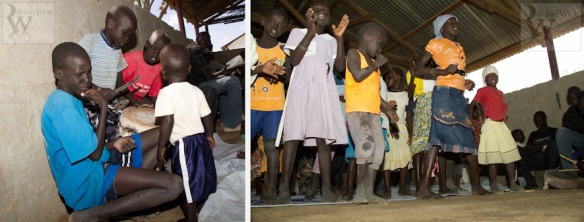
The community are currently using this hall as their makeshift place of worship. Though there are just a few chairs and the majority of people have to sit on the floor, they are making the most of the limits they must operate within. Here, children dance and play drums during a Saturday prayer meeting.

Though they are few, these people do not feel forgotten. On this occasion, a group of guest preachers from the Kenya Police have come from Garissa, two to four hours away by road and the largest town in North Eastern Province. Left: Clutching their Bibles, special guests listen attentively as one of their number speaks. Right: A member of the Sudanese community gives heartfelt thanks after the meeting. In contrast to this open gathering, TSM's support to Dadaab's Somali Christians is underground. These believers fear for their lives as they practise their faith. In September this year, after being tracked from Somalia, one of the MBBs was badly beaten alongside his family, an attack that caused the death of one of his children. TSM therefore takes great care when it reaches out to these people, as it is determined to maintain contact with them. When its staff visit their camp, they spend quality time with them, encouraging them in their faith. Recently, they were able to show them a film on Jesus in Somali, and prior to this they had already provided them with Somali Bibles to enable them to study the word of God and quietly conduct their private Sunday services.

This is the church of Dadaab's Gambela community, Christians from Western Ethiopia. Specifically, they are of Anuak ethnicity; in the face of increasing in-migration from 'highlanders', these 'lowlanders' asserted that Gambela is their historical home. They came to Dadaab in 2004 following a massacre by government forces that killed over 400 of them, supposedly carried out in response to the murder of eight highlanders. Though they have supposedly been given safe haven here in Dadaab, they still face significant challenges. In addition to the insecurity of being minority Christians, many suffer continued trauma from what they went through before arriving here, and also mental anguish from being separated from loved ones who may now be alive or dead. They find solace in their church, which they have called ‘God’s Help Church’, and its services are so well-attended every Sunday that it becomes full till the point where some can only get a view from outside the open door.

Church is very much a part of life here, and mothering duties do not stop at its threshold. In this shot, a woman continues her feeding duties without taking her eye off the pastor as he preaches. Several of the choristers, seated to the right, are also mothers and tend to their children while they are not on their feet to sing.

Women in prayer (left), Bible study (centre) and receiving communion (right). These are the lucky ones; some churches at Dadaab are crying out for Bibles and communion utensils, while others lack trained pastors. As devout Christians, they feel the need not only for physical sustenance during this time of chronic drought, but also spiritual nourishment. In response to this need, TSM are seeking funds for Bible provision, improved seating conditions, etc.

Tradition meets modernity in the Gambela church choir. Right: Though the service is deeply rooted in custom, this chorister's bandana shows that globalisation is alive and well. Left: Now taking the lead among the choristers, Ariet Omot Didumu has been a member of this choir since she was 12 years old. She says that over the course of all that she's been through, she has always known that God is there. Just knowing that He is present makes life a lot easier for her, so she says her spirit is continually boiling to worship Him. Praising Him together with this group fills her with joy, and spiritually this is tremendously uplifting for her.
Gambela church at Dadaab
Click the link above to hear Ariet Omot Didumu and her colleagues for yourself as they belt their lungs out to the rhythm of traditional Gambela drumming.

Providing a rhythm for proceedings on goat skin covered drums.

Children who didn't manage to get a seat inside find other ways of attending the service. Left: A boy joins in as the congregation prays. Right: Two girls take a relaxed peak through the window.

Outside, Sunday school gets underway. This will be its last outdoor session, as the building behind the children will house them from the following Sunday onwards. Its construction has just been completed and the clay - which appears damp in this image (left) - is still setting. Right: Full of enthusiasm for the little ones gathered all around him, the Sunday school teacher teaches them about the Israelites' journey from Egypt to the Promised Land.

Left: Children pay close attention to their Sunday school teacher. Right: Church drummers in training. Most of these children were born in Dadaab, and this is the only home they have ever known. Will they ever go 'back' to Ethiopia? From what their parents understand, every government that takes the reins in their country follows the same plan. According to the parson, Reverend Thwol Omot Odola, “in Gambela, you cannot find an educated person with grey hair. The moment they find an educated person, they will kill him”. Indeed, Dadaab is still receiving new arrivals from Gambela who are escaping the political situation and forced acquisition of their lands for industrial development.

Reverend Thwol Omot Odola (left), Church Women's Committee Chairwoman Ariet Olan Kwot (centre) and chorister and Women's Committee member Ariet Omot Didumu (right) speak of the massacre that caused them to flee their homeland, the difficult journey they took to reach Kenya and their life in Dadaab since then. Here, they say they experience relative security compared to what they faced before, and they keep praying to God to keep them safe. However, they continue to live somewhat in fear because they experience antipathy and even occasional attacks on individuals by the Somali Muslim majority population of the surrounding camps, against which forces of law and order seem totally ineffective. Gambela community leaders have tried to enter into dialogue with the leaders of the local Somali community, but these discussions have so far made no positive difference because the elders apparently deny control over 'rogue cases'. In terms of their daily survival, the two ladies pictured here speak of the role they play as part of the Women's Committee. The UNHCR only gives 3 kg of foodstuff for each person for 15 days, which they find insufficient for their basic needs. They have therefore set up a decorative bead making cooperative to generate income, so that their members' households can purchase additional food.
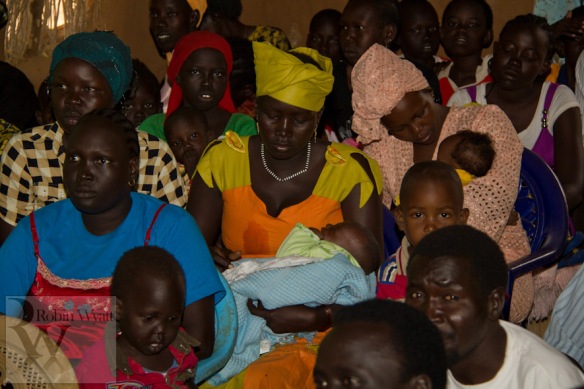
Here, mothers from Sudan sit with their infants in the congregation of Dadaab's Episcopal church. Sudanese Christians number around 1,200 in Dadaab. The civil war between northern and southern Sudan caused many people to flee. They started coming to Kenya in 1992, and were given the protection of the UNHCR and the Kenyan government in Kakuma. The UNHCR then started resettling some of these refugees in Dadaab in 1995, making its decisions on a case-by-case basis. The ones it sent here were those with personal situations that prevented them from returning to Sudan, such as expectations of reprisals. As a Christian, life in Dadaab is not easy, they say. Even when shopping or going for the distribution of relief food, they can be insulted as 'people without religion', a word in Somali that puts them on par with the Devil. Speaking back can result in getting knifed or beaten. The police apparently do not help, either because they are corruptible, they are not strong enough or their station is simply too far away, so it's not considered worth taking problems to them. They therefore try not to react when provoked, as encouraged by their religious leaders. Women only visit the market and relief distribution in groups, and often wear veils for fear of getting stoned. The community's women's group, supported by the UNHCR and Care International, were at one point given some money to start a restaurant. However, nobody would come to it because it was said that the food was prepared only for Christians (i.e. it was not halal). In the market, Somalis sell to 'the minorities' at a higher price. This means that the small amount of money these people earn from their UNHCR allowance and the incentive work that many of them do for relief agencies becomes insufficient to supplement their food rations and cover other basic necessities such as firewood. “If we were staying here without God, we could not survive in this place”, says one woman. Still, the Sudanese Christians here agree that this life is better than going back to Sudan would be. They are therefore pinning their hopes on being resettled to third countries.

Left: Two women enjoying their Sunday service. Right: Proud to be African, in spite of all he's been through. It is because of their strong faith that these people are able to patiently endure their conditions, they say, and even forgive those who do them ill, continuing to regard those who persecute them as their brothers and sisters. They find the time taken by Christian fathers to counsel them tremendously helpful, as this gives them strength. They remain sure that God will show them the way, and are adamant that they will not convert to Islam just for the sake of their safety (as they have often been urged to do by local Somalis). “We will retain our faith in Jesus Christ”, asserts one woman. “He will answer our prayers one day”. They feel fortified in this conviction by TSM's periodic food distributions at times of need. And they know that at least for the time being, their children are in school, the Kenyan government gives them a greater degree of protection than they could get back in Sudan, and they have the right to work to supplement what the UNHCR gives them.

Pastor Ancent administers healing to the congregation, helping two children with their sight (left and centre) and a woman who suffers from goitre (right). Some of the members of this community have been suffering from chronic health conditions for years, and yet they say that Somalis somehow always get treated ahead of them at the hospital. They speculate on whether this is down to bribery, discrimination or both. One woman, who works as a nurse in the hospital, says that she sees a lot of things: the sidelining of Christians, pharmacists deliberately handing over drugs other than those prescribed, refusals to make referrals; even a woman who died through wilful neglect, with her child still in her womb. When she once spoke up about this, doing so put her in great danger. Others report being discriminated against during relief distribution, as the loaders and transporters conspire against them being able to take home their correct allocation. While the National Council of Churches of Kenya (NCCK) and Catholic Relief Services (CRS) don't make any special effort to assist Christians in this, despite being 'faith-based' organisations, these people are very grateful to TSM for their targeted help: “God answered our prayers”, they say.
Episcopal church, Dadaab – Sermon excerpt
Click the link above to hear Pastor Ancent preaching passionately on how Christians can heal themselves from disease and how the congregation should believe that they will one day return to their homeland.

Led by a small boy (left), members of the congregation file out of church one by one (right), shaking the hands of the pastor and church elders along the way. The church encourages a spirit of togetherness, love and unity in these people. They say that while some of their community used to get into fights among themselves, the counselling provided by the church changed this behaviour and now they're living together in peace. They remain sure that God will one day answer their prayers and lead them out of this place. From 1995 to 2000, a lot of Dadaab's Christians converted to Islam because they found life as minorities too tough. That time was apparently a lot harder than it is now. Those who remained true to their faith say they see how important it is to never give up: “God still has plans for us”, they insist, over and over again.
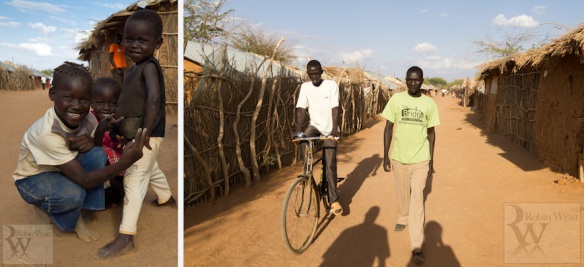
Returning home from church, along the lanes of Ifo Camp. “We are teaching our children and giving them hope”, says one man, “because we're like the Israelites, who were suffering in Egypt but were heard by God and taken to the Promised Land”. This man believes that one day, the Somali Muslims who persecute his people will ultimately learn from them. “They'll see that we have never done anything bad to them; we even love and pray for them, as our Bible tells us to pray for our enemies”. Hope, it seems, perseveres.
With thanks to Jonah Oswak for translation work with the Gambela community.















